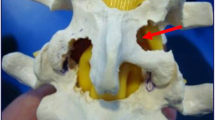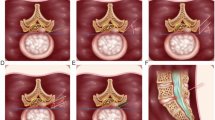Abstract
Background
Discectomy performed open orwith an operating microscope remains the standard surgical management. Tubular retractor system is being increasingly used. Potential benefits include less muscle and local damage, better cosmesis, decreased pain and operative time and faster recovery after surgery. We have evaluated the outcome of micro endoscopic discectomy (MED) utilizing tubular retractors in terms of safety and efficacy of the technique.
Materials and Methods
188 consecutive patients who underwent surgery for herniated disc using the tubular retractors between April 2007 and April 2012 are reported. All patients had a preoperative MRI (Magnetic Resonance Imaging) and were operated by a single surgeon with the METRx system (Medtronic, Sofamor-Danek, Memphis, TN) using 18 and 16 mm ports. All patients were mobilized as soon as pain subsided and discharged within 24–48 hours post surgery. The results were evaluated by using VAS (Visual Analog Scale 0–5) for back and leg pain and ODI (Oswestry Disability Index). Patients were followed up at intervals of 1 week, 6 weeks, 3 months, 6 months, 12 months and 2 years.
Results
The mean age of patients was 46 years (range 16–78 years) and the sex ratio was 1.5 males to 1 female. The mean followup was 22 months (range 8–69 months). The mean VAS scale for leg pain improved from 4.14 to 0.76 (P < 0.05) and the mean VAS scale for back pain improved from 4.1 to 0.9 (P < 0.05). The mean ODI changed from 59.5 to 22.6 (P < 0.05). The mean operative time per level was about 50 minutes (range 20–90 minutes). Dural punctures occurred in 11 (5%) cases. Average blood loss was 30 ml (range 10–500 ml). A wrong level was identified and later corrected in a case of revision discectomy. Four patients with residual disc-herniation had revision MED and three patients with recurrent disc herniation later underwent fusion. One patient had wound infection which needed a debridement.
Conclusion
MED for herniated discs effectively achieves the goals of surgery with minimal access. The advantages of the procedure are cosmesis, early postoperative recovery and minimal postoperative morbidity.
Similar content being viewed by others
References
Mixter WJ, Barr JS. Rupture of the intervertebral disc with involvement of the spinal canal. N Engl J Med 1934;211:210–5.
Kambin P, Savitz MH. Arthroscopic microdiscectomy: An alternative to open disc surgery. Mt Sinai J Med 2000;67:283–7.
Caspar W. A new surgical procedure for lumbar disc herniation causing less tissue damage through a microsurgical approach. In: Wullenweber R, Brock M, Hamer J (Editors), Advances in Neurosurgery. Berlin: Springer-Verlag; 1977. p. 74–7.
Yasargil MG. Microsurgical operation for herniated disc. In: Wullenweber R, Brock M, Hamer J, Klinger M, Spoerri O, (Editors). Advances in Neurosurgery. Berlin: Springer-Verlag; 1977. p. 81.
Williams RW. Microlumbar discectomy: A conservative surgical approach to the virgin herniated lumbar disc. Spine (Phila Pa 1976) 1978;3:175–82.
Foley KT, Smith MM. Microendoscopic discectomy. Techniques in Neurosurgeryl 997;3:301–7.
Kulkarni AG, Dhruv AN, Bassi AJ. Microendoscopic Excision of C2 osteoid osteoma: A Technical Report. Spine (Phila Pa 1976) 2008;38:E1231–4.
Atlas SJ, Keller RB, Wu YA, Deyo RA, Singer DE. Longterm outcomes of surgical and nonsurgical management of sciatica secondary to a lumbar disc herniation: 10 year results from the Maine lumbar spine study. Spine (Phila Pa 1976) 2005;30:927–35.
Pearson AM, Blood EA, Frymoyer JW, Herkowitz H, Abdu WA, Woodward R, et al. SPORT lumbar intervertebral disk herniation and back pain: Does treatment, location, or morphology matter? Spine (Phila Pa 1976) 2008;33:428–35.
Peul WC, van Houwelingen HC, van den Hout WB, Brand R, Eekhof JA, Tans JT, et al. Surgery versus prolonged conservative treatment for sciatica. N Engl J Med 2007;356:2245–56.
Gibson JN, Waddell G. Surgical interventions for lumbar disc prolapse: Updated Cochrane Review. Spine (PhilaPa 1976) 2007;32:1735–47.
Tait MJ, Levy J, Nowell M, Pocock C, Petrik V, Bell BA, et al. Improved outcome after lumbar microdiscectomy in patients shown their excised disc fragments: A prospective, double blind, randomised, controlled trial. J NeurolNeurosurg Psychiatry 2009;80:1044–6.
Katayama Y, Matsuyama Y, Yoshihara H, Sakai Y, Nakamura H, Nakashima S, et al. Comparison of surgical outcomes between macro discectomy and micro discectomy for lumbar disc herniation: A prospective randomized study with surgery performed by the same spine surgeon. J Spinal Disord Tech 2006;19:344–7.
McGirt MJ, Ambrossi GL, Datoo G, Sciubba DM, Witham TF, Wolinsky JP, et al. Recurrent disc herniation and long term back pain after primary lumbar discectomy: Review of outcomes reported for limited versus aggressive disc removal. Neurosurgery 2009;64:338–45.
Freudenstein D, Duffner F, Bauer T. Novel retractor for endoscopic and microsurgical spinal interventions. Minim Invasive Neurosurg 2004;47:190–5.
Husain M, Jha DK, Agrawal S, Husain N, Gupta RK. Conical working tube: A special device for endoscopic surgery of herniated lumbar discs. J Neurosurg Spine 2005;2:265–70.
Isaacs RE, Podichetty V, Fessier RG. Microendoscopic discectomy for recurrent disc herniations. Neurosurg Focus 2003;15:E11.
Schick U, Döhnert J, Richter A, König A, Vitzthum HE. Microendoscopic lumbar discectomy versus open surgery: An intraoperative EMG study. Eur Spine J 2002;11:20–6.
Shin DA, Kim KN, Shin HC, Yoon H. The efficacy of Microendoscopic discectomy in reducing iatrogenic muscle injury. J Neurosurg Spine 2008;8:39–43.
Kotil K, Tunckale T, Tatar Z, Koldas M, Kural A, Bilge T. Serum creatine Phosphokinase activity and histological changes in the multifidus muscle: A prospective randomized controlled comparative study of discectomy with or without retraction. J Neurosurg Spine 2007;6:121–5.
Harrington JF, French P. Open versus minimally invasive lumbar microdiscectomy: Comparison of operative times, length of hospital stay, narcotic use and complications. Minim Invasive Neurosurg 2008;51:30–5.
Yeung AT, Yeung CA. Minimally invasive techniques for the management of lumbar disc herniation. Orthop Clin North Am 2007;38:363–72.
Mayer HM, Brock M. Percutaneous endoscopic discectomy: Surgical technique and preliminary results compared to microsurgical discectomy. J Neurosurg 1993;78:216–25.
Ditsworth DA. Endoscopic transforaminal lumbar discectomy and reconfiguration: A postero-lateral approach into the spinal canal. SurgNeurol 1998;49:588–98.
Ranjan A, Lath R. Microendoscopic discectomy for prolapsed lumbar intervertebral disc. Neurol India 2006;54:190–4.
Garg B, Nagraja UB, Jayaswal A. Microendoscopic versus open discectomy for lumbar disc herniation: A prospective randomised study. J Orthop Surg (Hong Kong) 2011;19:30–4.
Jhala A, Mistry M. Endoscopic lumbar discectomy: Experience of first 100 cases. Indian J Orthop 2010;44:184–90.
Kaushal M, Sen R. Posterior endoscopic discectomy: Results in 300 patients. Indian J Orthop 2012;46:81–5.
Smith L, Brown JE. Treatment of lumbar intervertebral disc lesion by direct injection of chymopapain. J Bone Joint Surg Br 1967;49:502–19.
Hijikata S. Percutaneous nucleotomy. A new concept technique and 12 years’ experience. Clin Orthop Relat Res 1989;238:9–23.
Onik G, Helms CA, Ginsberg L, Hoaglund FT, Morris J. Percutaneous lumbar diskectomy using a new aspiration probe. Am J Roentgenol 1985;144:1137–40.
Choy DS, Ascher PW, Ranu HS, Saddekni S, Alkaitis D, LieblerW, et al. Percutaneous laser disc decompressions: Anew therapeutic modality. Spine (Phila Pa 1976) 1992;17:949–56.
Arts MP, Brand R, van den Akker ME, Koes BVV, Bartels RH, Tan WF, et al. Tubular diskectomy vs conventional microdiscectomy for the treatment of lumbar disk herniation: 2-year results of a double-blind randomized controlled trial. Neurosurgery 2011;69:135–44.
Härd R. Comment to the article: “Tubular diskectomy vs conventional microdiskectomy for sciatica: A randomized controlled trial“. Minim Invasive Neurosurg 2010;53:95–6.
Righesso O, Falavigna A, Avanzi O. Comparison of open discectomy with microendoscopic discectomy in lumbar disc herniations: Results of a randomized controlled trial. Neurosurgery 2007;61:545–9.
Ruetten S, Komp M, Merk H, Godolias G. Full-endoscopic interlaminar and transforaminal lumbar discectomy versus conventional microsurgical technique: A prospective, randomized, controlled study. Spine (PhilaPa 1976) 2008;33:931–9.
Wu X, Zhuang S, Mao Z, Chen H. Microendoscopic discectomy for lumbar disc herniation: Surgical technique and outcome in 873 consecutive cases. Spine (Phila Pa 1976) 2006;31:2689–94.
Ebling U, Reichenberg W, Reulen HJ. Results of microsurgical lumbar discectomy. Review on 485 patients. ActaNeurochir 1986;81:45–52.
Caspar W, Campbell B, Barbier DD, Kretschmmer R, Gotfried Y. The Caspar microsurgical discectomy and comparison with a conventional standard lumbar disc procedure. Neurosurgery 1991;28:78–87.
Pappas CT, Harrington T, Sonntag VK. Outcome analysis in 654 surgical treated lumbar disc herniations. Neurosurgery 1992;30:862–6.
Chen Z, Zhao J, Liu A, Yuan J, Li Z. Surgical treatment of recurrent lumbar disc herniation by transforaminal lumbar interbody fusion. Int Orthop 2009;33:197–201.
Tullberg T, Isacson J, Weidenhielm L Does microscopic removal of lumbar disc herniation lead to better results than the standard procedure? Result of a one-year randomized study. Spine (Phila Pa 1976) 1993;18:24–7.
Perez-Cruet MJ, Foley KT, Isaacs RE, Rice-Wyllie L, Wellington R, Smith MM, et al. Microendoscopic Lumbar Discectomy: Technical Note. Neurosurgery 2002;51:S129–36.
Nakagawa H, Kamimura M, Uchiyama S, Takahara K, Itsubo T, Miyasaka T. Microendoscopic discectomy (MED) for lumbar disc prolapse. J Clin Neurosci 2003;10:231–5.
Arts MP, Brand R, van den Akker ME, Koes BW, Bartels RH, Peul WC. Tubular diskectomy vs conventional microdiskectomy for sciatica: A randomized controlled trial. JAMA 2009;302:149–58.
Muramatsu K, Hachiya Y, Morita C. Postoperative magnetic resonance imaging of lumbar disc herniation: Comparison of microendoscopic discectomy and Love’s method. Spine (Phila Pa 1976) 2001;26:1599–605.
Schizas C, Tsiridis E, Saksena J. Microendoscopic discectomy compared with standard microsurgical discectomy for treatment of uncontained or large contained disc herniations. Neurosurgery 2005;57 (4 Suppl):357–60.
Bookwalter JW III, Busch MD, Nicely D. Ambulatory surgery is safe and effective in radicular disc disease. Spine (Phila Pa 1976) 1994;19:526–30.
Teli M, Lovi A, Brayda-Bruno M, Zagra A, Corriero A, Giudici F, et al. Higher risk of dural tears and recurrent herniation with lumbar micro-endoscopic discectomy. Eur Spine J 2010;19:443–50.
Nowitzke A. Assessment of the learning curve for Lumbar Microendoscopic Discectomy. Neurosurgery 2005;56:755–62.
Author information
Authors and Affiliations
Corresponding author
Rights and permissions
About this article
Cite this article
Kulkarni, A.G., Bassi, A. & Dhruv, A. Microendoscopic lumbar discectomy: Technique and results of 188 cases. IJOO 48, 81–87 (2014). https://doi.org/10.4103/0019-5413.125511
Published:
Issue Date:
DOI: https://doi.org/10.4103/0019-5413.125511




